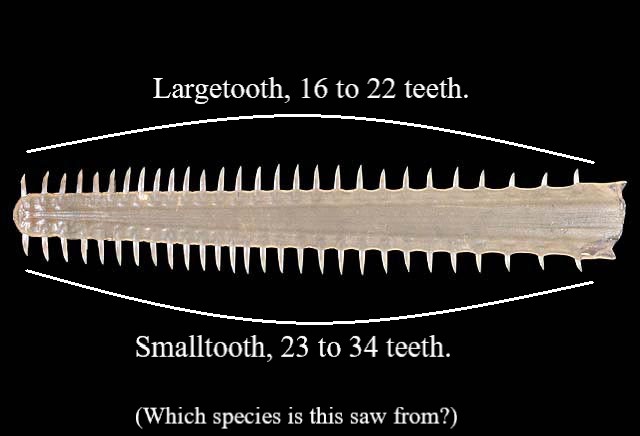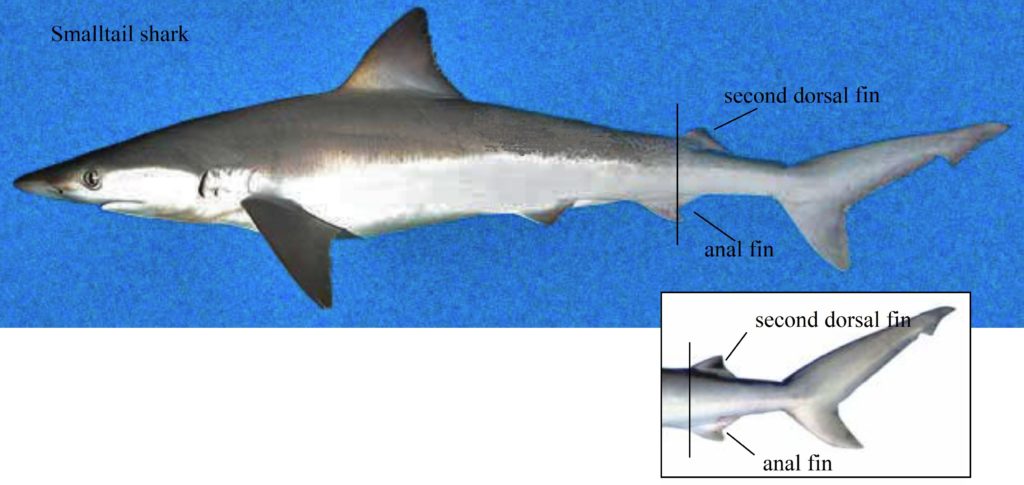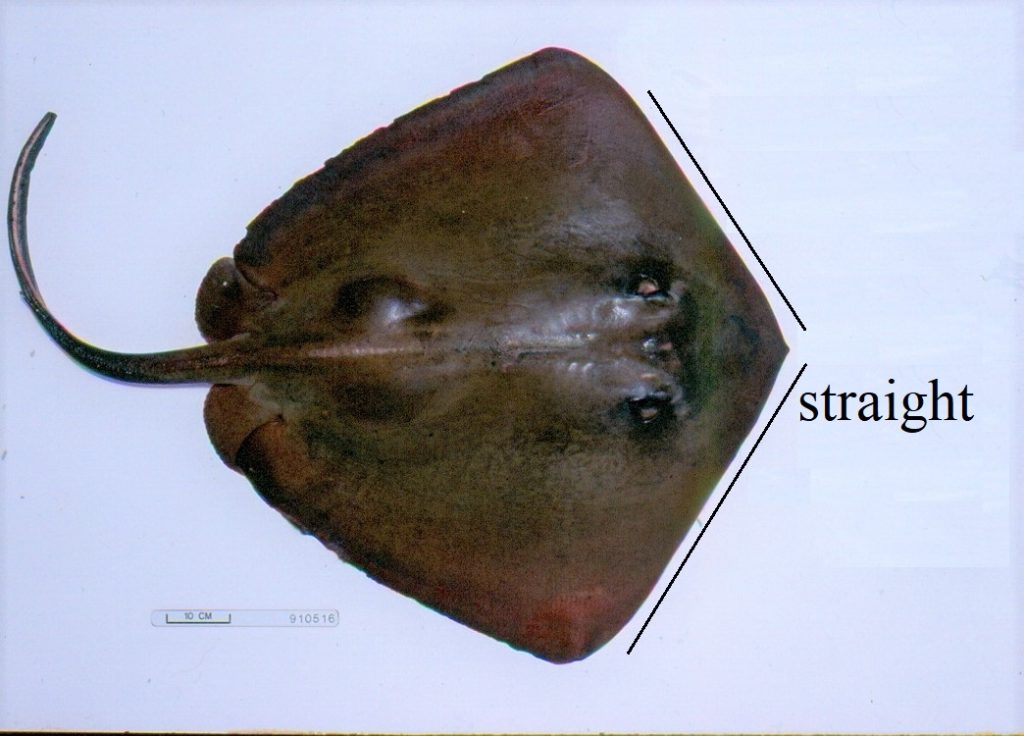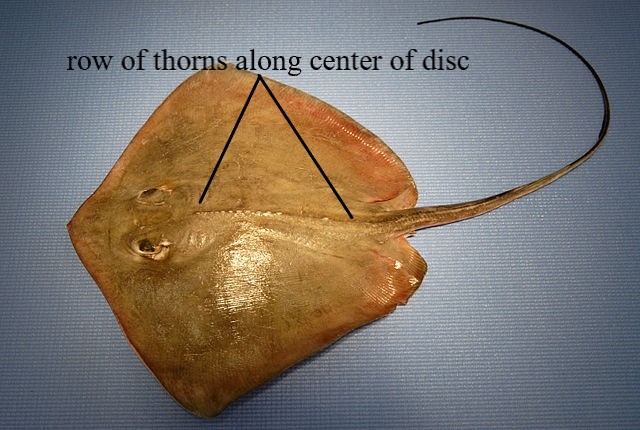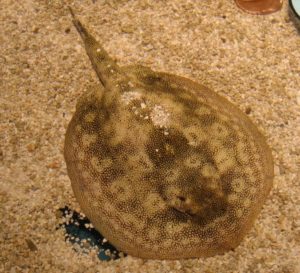Introduction
Note: The populations of some of the sharks that are found in the Gulf of Mexico have been declining for a number of years. To provide an indication of this decline, species that are listed by the International Union for the Conservation of Nature as critically endangered (CR), endangered (EN), vulnerable (VU) or near threatened (NT) will be indicated in the descriptions below. If you are a fisher it is important to familiarize yourself with those species and, if you capture an endangered or critically endangered species, please release the fish as quickly as possible unharmed. (Some of the information contained herein is taken from Sharks, Skates and Rays of the Gulf of Mexico, by Glenn R. Parsons, University Press of Mississippi: https://www.upress.state.ms.us.)
In the Gulf of Mexico, there are about 50 different species of sharks and about the same number of skates and rays. Everyone knows what a shark looks like but many don’t recognize the difference between skates and rays. Rays typically have a stinging barb at the base of the tail whereas skates have no barb and are relatively harmless. See below for more information regarding some of the common Gulf of Mexico skates and rays.
How to Identify Your Fish
Please answer these simple questions to help you identify the shark, stingray or skate.
- Is the skin of the shark smooth between the 1st and 2nd dorsal fins? YES, see #1 below?
- Does the shark have a low ridge of skin between the 1st and 2nd dorsal fins? NO, see #2 below.
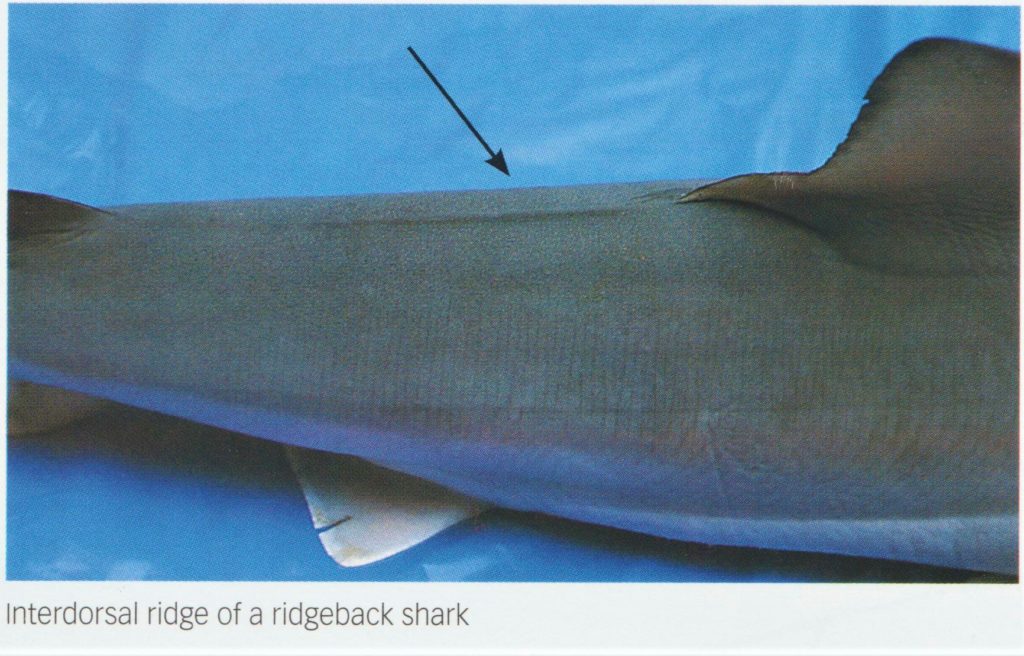
- Is it a hammerhead shark? See #3 below.
- Is it flattened like a stingray? See #4 below (but be sure to look at the angel shark below)
- Does it have a saw-like snout? See #5 below.
1. Non-Ridgeback Sharks
Common Inshore Sharks
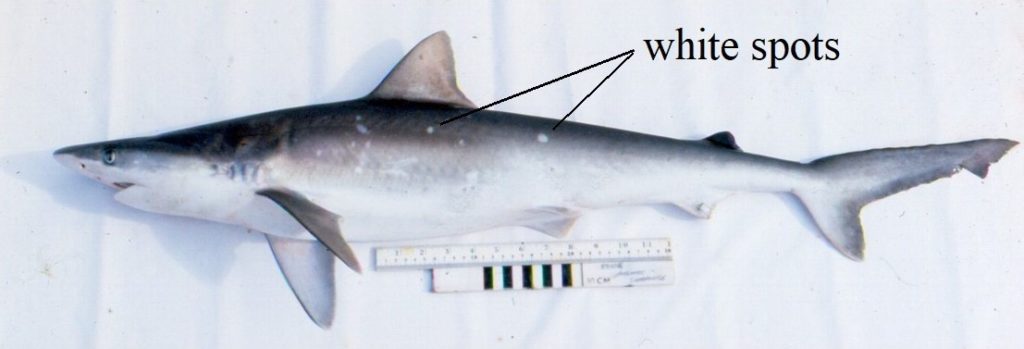
Atlantic Sharpnose Shark
The Atlantic sharpnose shark is the most common inshore species in many areas of the northern Gulf of Mexico. It is small, growing to only about 4 feet in length. These sharks, along with 5 or 6 other species, are often called “sand sharks”. If the shark is less than about 2 feet and is not a hammerhead shark, it is undoubtedly a sharpnose shark. No other shark in our area has white spots along its back and flanks. Image credit, Apex Predators Program, NOAA/NEFSC.
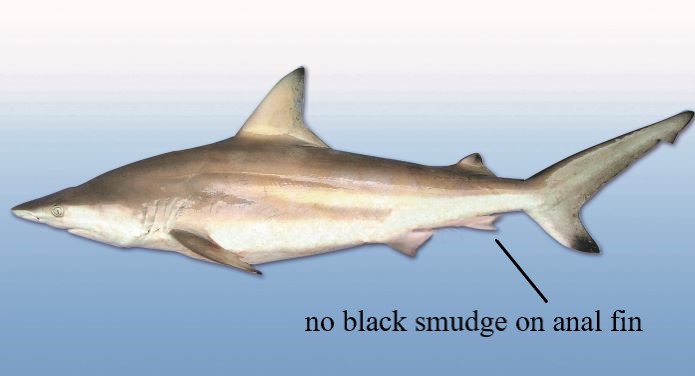
Blacktip Shark (NT)
The blacktip shark may be the second most common shark in the northern Gulf of Mexico. It is often confused with the spinner shark but the spinner shark typically has black pigment on its anal fin. Maximum size about 6.5 feet. Image credit, Eric Hoffmayer, NMFS, Pascagoula.

Spinner Shark (VU)
The spinner shark, another common shark, is very similar to the blacktip shark and these species are often confused by fishers. The spinner shark has a narrower and longer snout than the blacktip which is easily discernible when the fishes are laid side-by-side. However, the easiest characteristic to differentiate between these species is the black coloration on the anal fin of the spinner shark. Maximum size about 7.5 feet. Image credit, Eric Hoffmayer, NMFS Pascagoula.
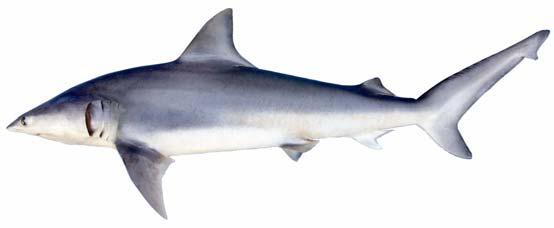
Finetooth Shark (NT)
The finetooth shark is relatively common in the northern Gulf of Mexico. This species has a striking bluish-grey color when alive that fades quickly. As the name implies, the shark has fine, needle-like teeth in both upper and lower jaws. maximum size is about 6 feet. Image credit, NMFS, E. Hoffmayer, S. Iglésias and R. McAuley.

Bull Shark (NT)
The bull shark is not abundant but is regularly taken in some areas of the northern Gulf of Mexico. Juveniles are not uncommon in the lower salinity bays and estuaries. The snout of the bull shark is very short, its length less than the width of the mouth and rounded. The body is stockier than other common species. Maximum size is about 11 feet. Image credit, Eric Hoffmayer, NMFS Pascagoula.
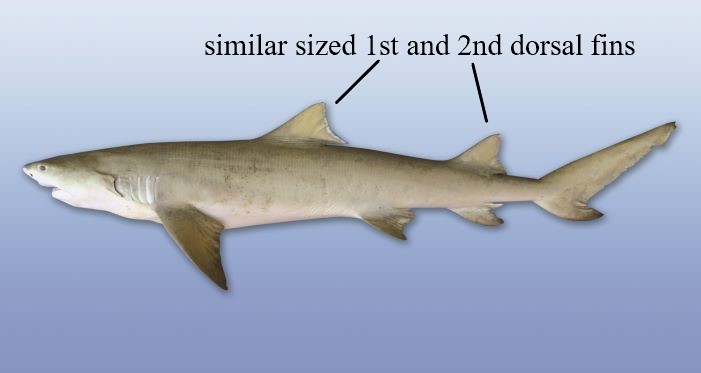
Lemon Shark (VU)
The lemon shark is more common along the coast of south Florida where juveniles can be seen among the mangroves. The first and second dorsal fins of this species are similar in size and the snout is broad and short. This shark is yellow brown, dark brown or olive gray. Maximum size is about 10 feet. Image credit, Eric Hoffmayer, NMFS Pascagoula.
Less Common Sharks
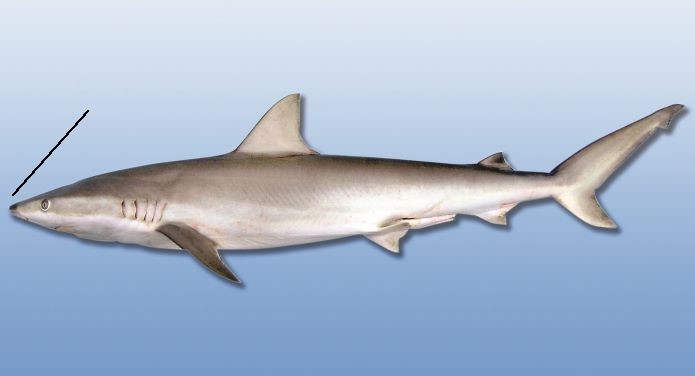
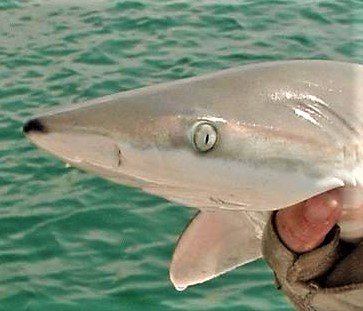
Blacknose Shark (EN)
The blacknose shark is a relatively non-descript species except for the black smudge on the tip of the snout which is characteristic of this shark. Blacknose sharks are reported to be endangered as their numbers have declined in recent years. Maximum size is about 5 feet. Images: Left, Eric Hoffmayer; Right, Public Domain; Brandi Noble, SEFSC Pascagoula Laboratory, NOAA.

Atlantic Nurse Shark (VU)
Nurse sharks are sometimes seen in shallow waters in the northern Gulf but most commonly the large adults are reported from deeper waters. Nurse sharks are a dark to light brown, have similar-sized dorsal fins and the 1st dorsal is set far back on the body. The most distinguishing characteristic however, are the very obvious nasal barbels that appear as “fangs” but are merely fleshy sensory appendages. Maximum size is about 14 feet. Image credits: Brandi Noble, NOAA Pascagoua La;, Apex Predators Program, NEFSC/NOAA.

Florida Smoothound (VU)


Smoothound Shark (NT)

It can be difficult to differentiate between the Florida Smoothound (top) and the Smoothound (bottom). The lower lobe of the tail fin is more pointed in the Florida Smoothound and more rounded in the Smoothound (see diagrams above).
Smalltail Shark (CR)
The smalltail shark is one of only two sharks that has the second dorsal positioned further back on the body than the anal fin. The inset above shows the relationship between the two fins in all other sharks except the Atlantic sharpnose which is similar to the smalltail. The Atlantic sharpnose shark is far more common in the northern Gulf of Mexico than the present shark and often has white spots. The maximum size of this shark is about 4 feet. Image credit; D. Ross Robertson, Wikimedia Commons.
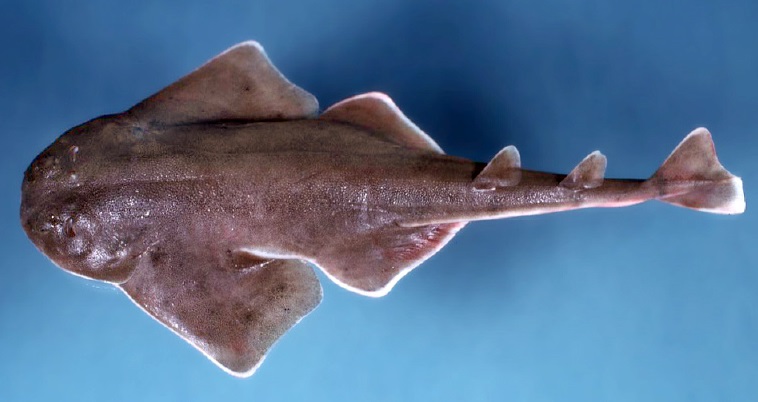
Angel Shark
The angel shark may not appear to be a shark at first because of its very large pectoral fins and large, blunt head. To distinguish this shark from a ray the pectoral fins are not attached to the head and the shark has a distinct “neck”. This species can be found in very deep waters but also in very shallow. Although not a common species they may be found in shallow waters and have been captured at over 4000 feet depth. Maximum size is about 5 feet. Image credit; Smithsonian Environmental Research Center, Wikimedia Commons.
Species More Common Offshore
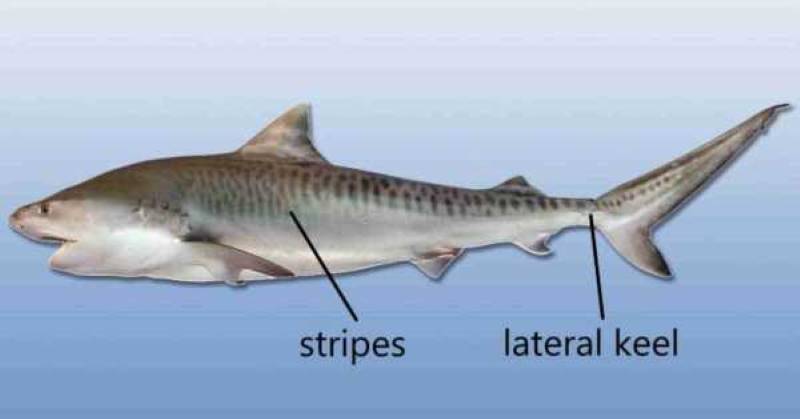
Tiger Shark (NT)
The tiger shark is a species that may occur in shallow waters but is more regularly captured in deeper waters. The blunt snout, stripes (which fade in very large specimens), notched teeth, and lateral keel (a shelf-like extension along the sides of the tail) are distinctive in this species. The tiger shark is a very large shark attaining lengths of 21 feet. Image credit; Albert Kok, Wikimedia Commons.
Blue Shark (NT)
The blue shark is a common species in offshore waters in the Gulf of Mexico. It has a slender, bullet-shaped body, and long pectoral fins. It is dark blue on top, bright blue along the sides and white below. Maximum size is about 12.5 feet. Image from “Sharks, skates and rays of the Gulf of Mexico, University Press of Mississippi.

Common Thresher (VU)

Bigeye Thresher (VU)
The thresher sharks are unmistakable possessing a long, scythe-like extension of the upper caudal fin. The bigeye thresher is easily distinguished from the common thresher as it has unusual grooves in the top of the head and the eye is large, oval, and directed upwards. Maximum size of the bigeye is about 15 feet and the common thresher is about 25 feet. Images from “Sharks, skates and rays of the Gulf of Mexico, University Press of Mississippi.
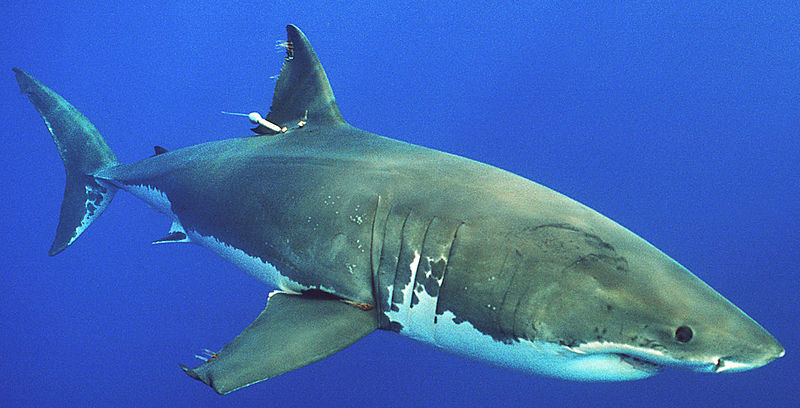
White Shark (CR)
The white shark is an uncommon visitor in the offshore waters of the Gulf of Mexico and very rarely seen in inshore waters. This shark is critically endangered. Although rare, white sharks in the Gulf are typically spotted in the winter months. Bullet-shaped body, cone-shaped snout, and a lunate (shaped like a crescent moon) caudal are all characteristic of white sharks. There is a black spot near the base of the pectoral fin. Maximum recorded size was about 24 feet. Image credit, Phillip Colla, Wikimedia Commons.
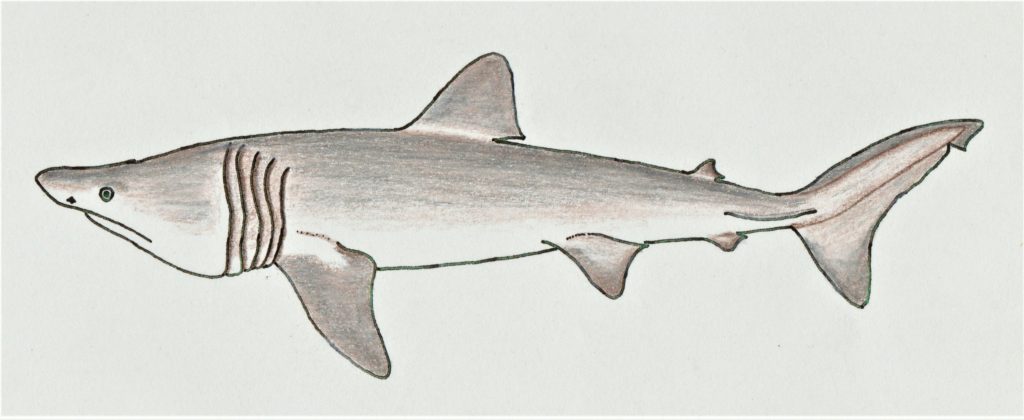
Basking Shark (EN)
Basking sharks are the second largest fish in the world attaining a maximum length of about 33 feet but are harmless filter feeders. Characteristics: very long gill slits, long conical snout, brown, blue-gray to blackish above. Image from “Sharks, skates and rays of the Gulf of Mexico, University Press of Mississippi.
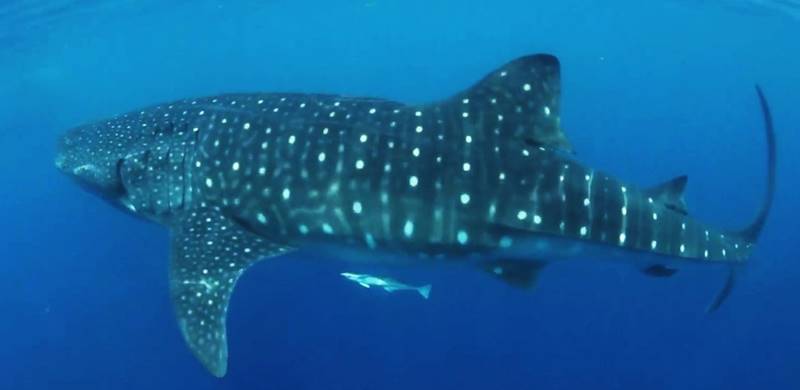
Whale Shark (EN)
Th largest fish in the world, these filter-feeding giants are regular inhabitants in the offshore waters of the Gulf of Mexico and very occasionally occur closer to shore. Maximum size is about 59 feet. Image credit, Eric Hoffmayer, NMFS Pascagoula, Laboratory.
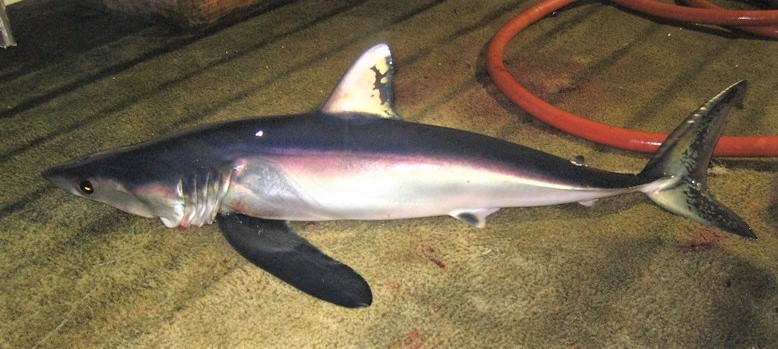
Longfin Mako (EN)
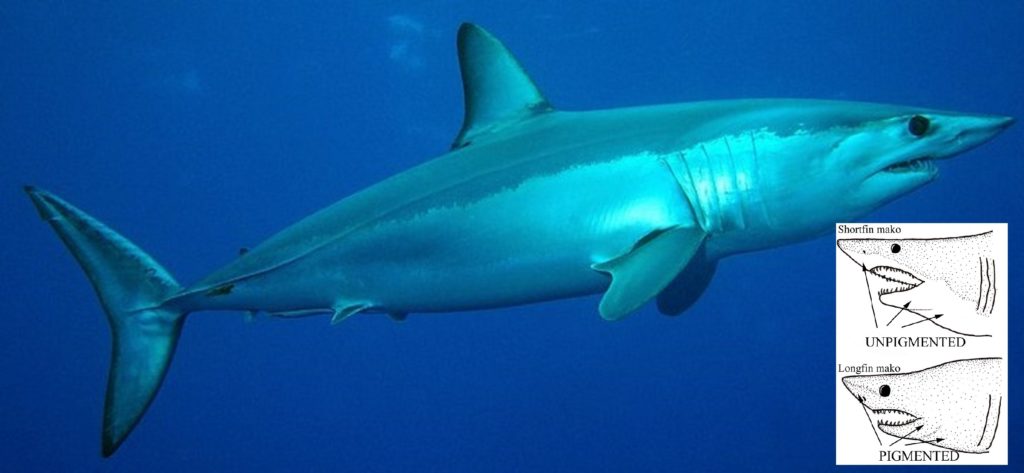
Shortfin Mako (EN)
The longfin mako shark is less common than the shortfin mako but is occasionally observed in the Gulf of Mexico. They are found in offshore waters. The pectoral fins are long and the color is intense blue on the back and sides. The longfin mako has pigmentation around the mouth whereas the shortfin mako does not. Image credit, (top) NOAA Observer Program, Wikimedia Commons and (bottom) Patrick Doll, Wikimedia Commons.
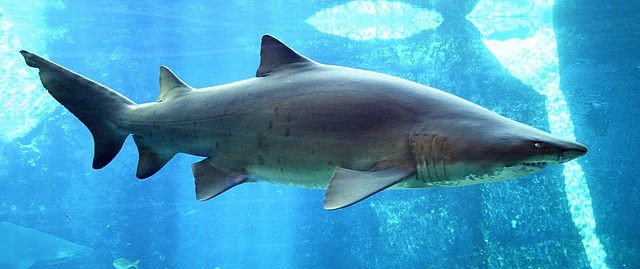
Sandtiger Shark (VU)
The most obvious feature of the sandtiger shark is its toothy mouth. The protruding teeth give this shark a ferocious appearance and make them a popular shark at public aquaria. This species has a stocky body, similar sized dorsal fins and the color on the upper surface is pale brown or gray with yellowish brown to reddish spots. Maximum size is about 10.5 feet. Image credit, Amada44, UShaka Sea World, Wikimedia Commons.
2. Ridgeback Sharks
The sharks described here each have an interdorsal ridge, a low ridge of skin that is found between the 1st and 2nd dorsal fins.
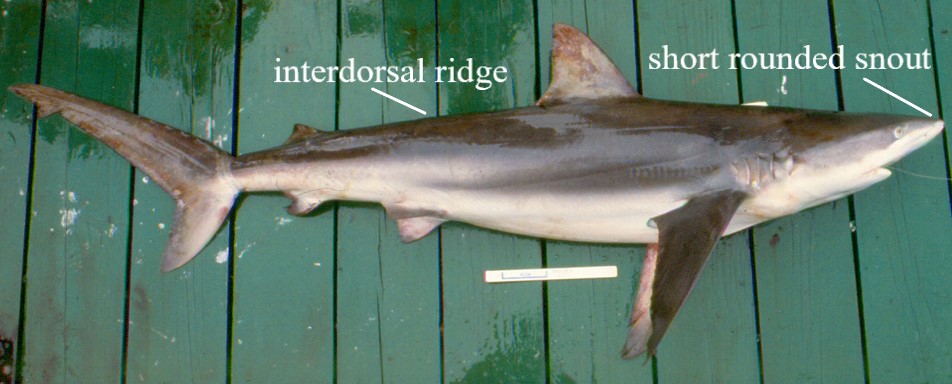
Dusky Shark (EN)
The dusky is uncommon in the northern Gulf of Mexico although it was once a common large shark in offshore waters. It is a ridgeback shark with a short rounded snout and dusky pigment on the tips of the pectoral, second dorsal, and caudal fins. Image: Apex Predators Program, NOAA/NEFSC.
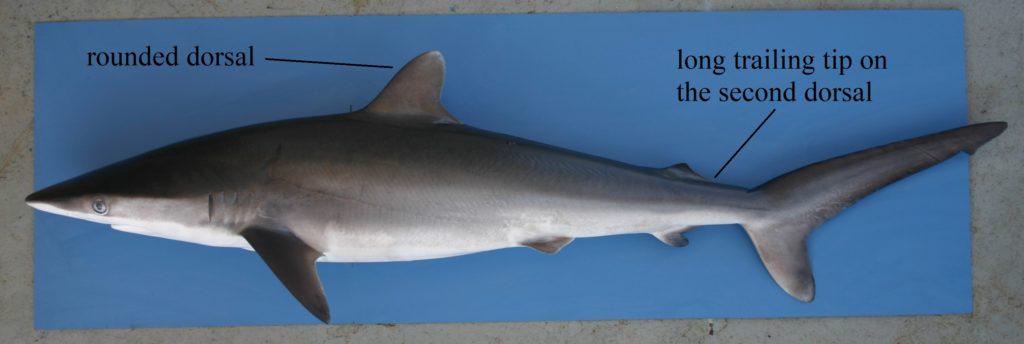
Silky Shark (VU)
The silky shark is often misidentified by fishers because it lacks easily identifiable characteristics. The shark has a slender body and a small, rounded dorsal fin. However, the characteristic that is most useful in identifying this species is the long trailing tip of the second dorsal fin. maximum size is about 115 feet. Image from “Sharks, skates and rays of the Gulf of Mexico, University Press of Mississippi.
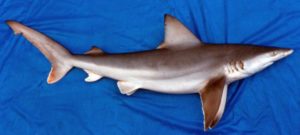
Sandbar Shark (VU)
The sandbar shark is a relatively stocky shark with a tall, broad, roughly triangular dorsal fin. The color is grey to brownish. Maximum size is about 10 feet. Image from “Sharks, skates and rays of the Gulf of Mexico, University Press of Mississippi.
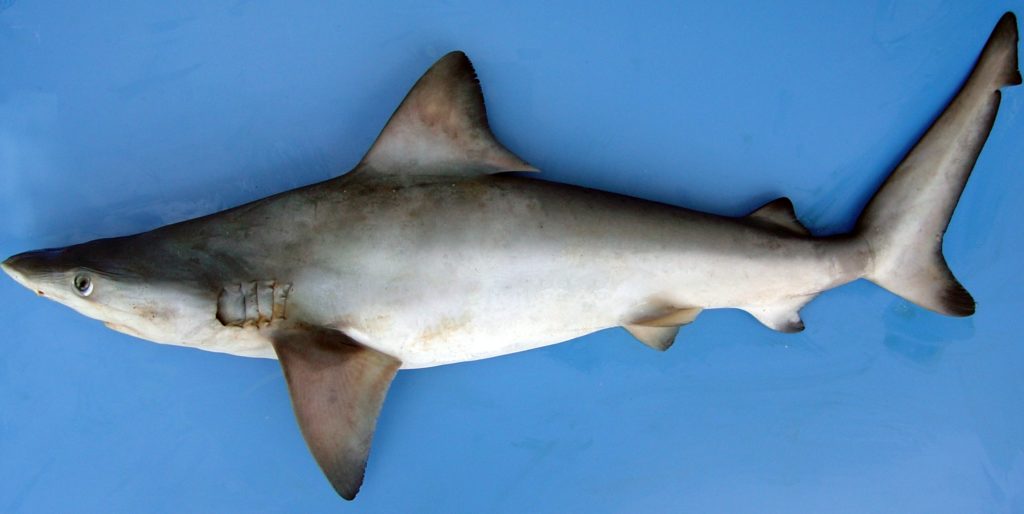
Bignose Shark (NT)
The bignose has a rounded snout and a large first dorsal. This shark may be confused with the sandbar shark but the sandbar sharks first dorsal fin is higher. Color is gray to bronze. Maximum size is about 9 feet. Image from “Sharks, skates and rays of the Gulf of Mexico, University Press of Mississippi.
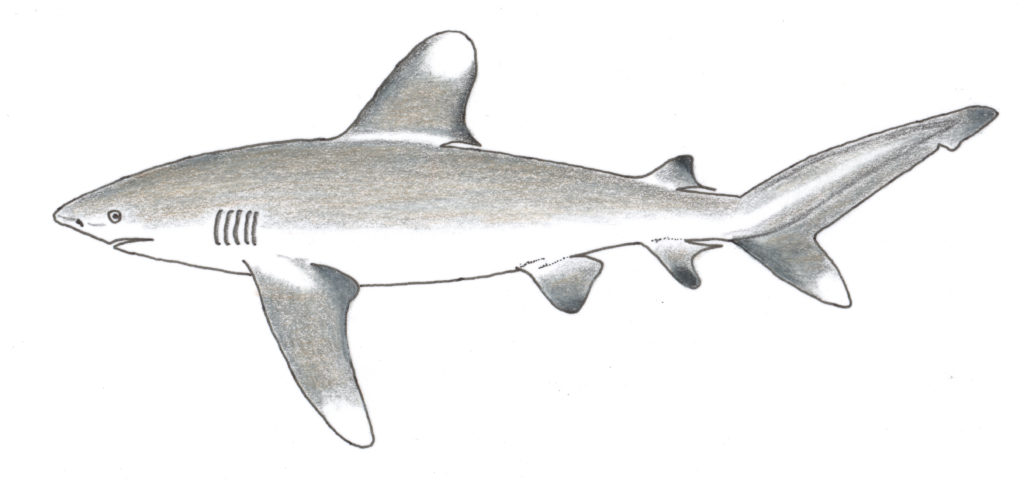
Oceanic Whitetip Shark (CR)
The oceanic whitetip shark is an “oceanic” species that is rarely seen inshore. This shark has a rounded pectoral fin and the dorsal and pectoral fins are tipped in white. Maximum size is about 13 feet. Image from “Sharks, skates and rays of the Gulf of Mexico, University Press of Mississippi.
3. Hammerhead Sharks
All of the hammerhead sharks are recognized by the shape of the head.
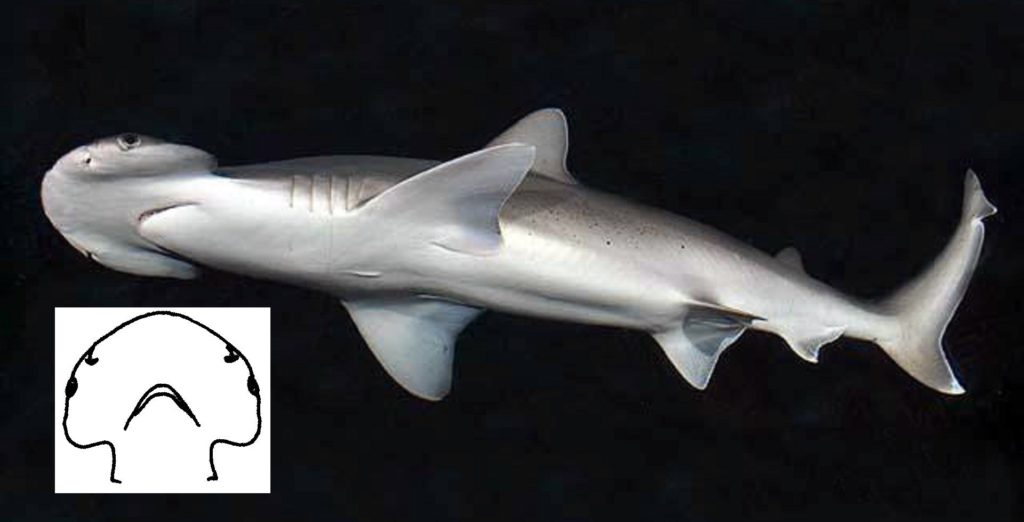
Bonnethead Shark (EN)
The bonnethead or shovelnose shark is the smallest hammerhead shark and, in the Gulf of Mexico, is more common east of Mobile Bay and along the coast of Florida. A relatively common inhabitant of seagrass meadows. The hammerhead’s head is shaped like a bonnet or a shovel. Maximum size is only about 4 feet. Image credit, D. Ross Robertson, Smithsonian Institution.
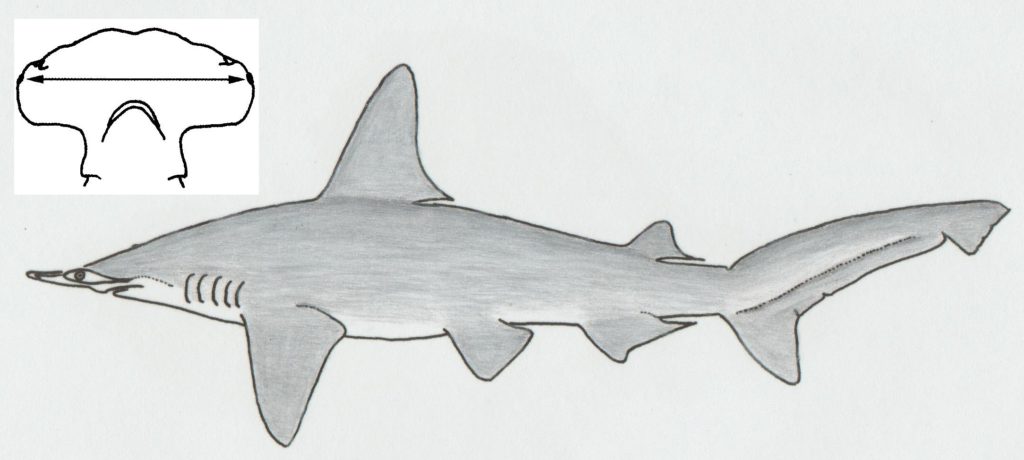
Smalleye Hammerhead (CR)
The smalleye hammerhead shark is very uncommon but has been reported from the northern Gulf of Mexico. The smalleye could be mistaken for the scalloped hammerhead, because it has a notch in the center of the hammer, but a line connecting the center of the eyes passes well forward of the mouth (see inset above). Maximum size is only about 4 feet. Image from “Sharks, skates and rays of the Gulf of Mexico, University Press of Mississippi.

Scalloped Hammerhead Shark (CR)
Although apparently critically endangered, the scalloped hammerhead is not uncommon in the Gulf of Mexico. This species can be distinguished from the great hammerhead, which it resembles, by the “swept-back” appearance of the hammer such that a line connecting the center of the eyes fall across the front edge of the mouth (see inset above). Maximum size is about 12 feet. Image credit, Wikimedia Commons, ErikvanB CC BY-SA 4.0
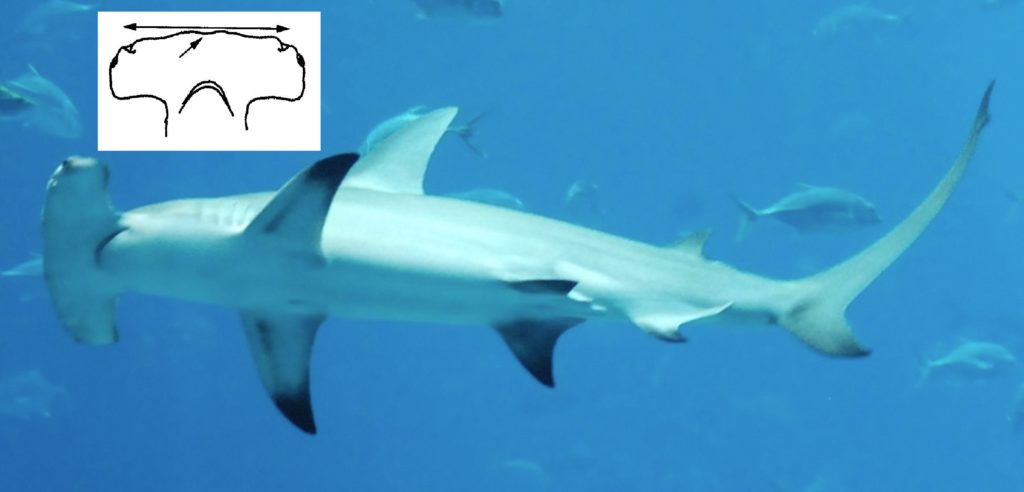
Great Hammerhead Shark (CR)
The great hammerhead shark has an extremely tall dorsal fin and a relatively straight leading edge of the hammer (see inset above). A line connecting the center of the eyes would fall far forward of the leading edge of the mouth. Light gray to brownish gray on the dorsal surface. Maximum size is about 20 feet. Image credit, Josh Hallett, Wikimedia Commons.
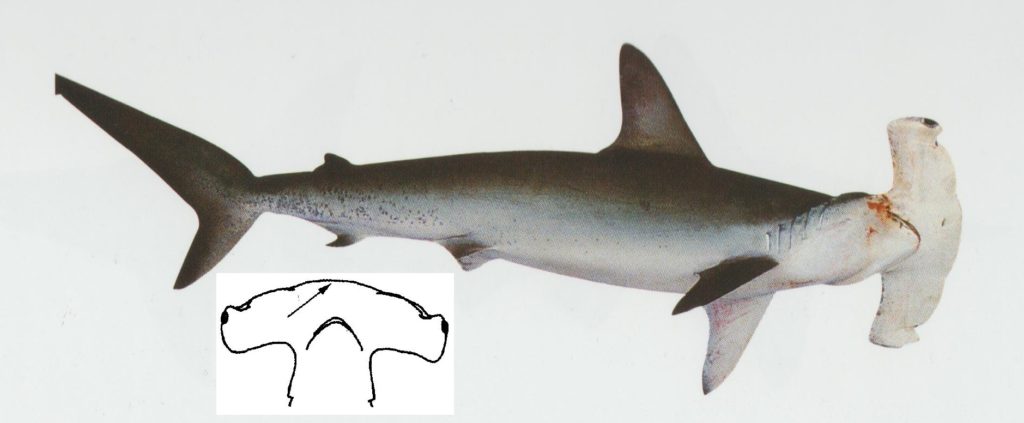
Smooth Hammerhead (VU)
The smooth hammerhead is very uncommon and has not been reported in the northern Gulf of Mexico but has been reported from the southern Gulf. It is olive to brownish grey on the dorsal surface. The distiguishing characteristic of this species is the absence of the notch in the center of the leading edge of the hammer (see inset above). Maximum size is about 13 feet. Image from “Sharks, skates and rays of the Gulf of Mexico, University Press of Mississippi.
4. Rays and Skates
This grouping includes the guitarfish and sawfishes that resemble sharks but are not, and the rays and skates. These fishes are grouped separately because they possess characteristics that are distinct from the sharks.
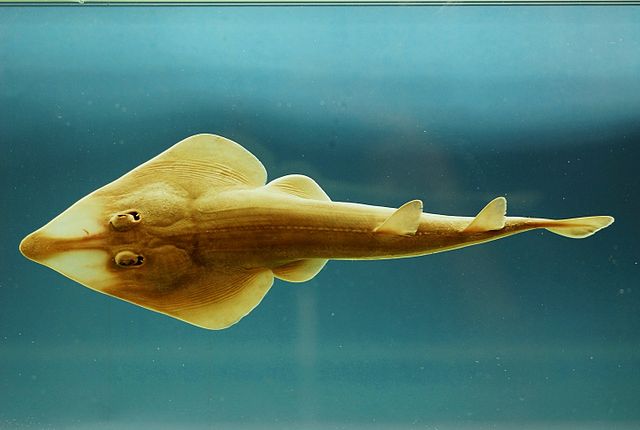
Atlantic Guitarfish (VU)
The guitar fish is an oddly shaped fish that can be misidentified as a shark. Relative of the rays and skates it has a wedge-shaped head, and muscular elongate tail. It is grey to olive brown to chocolate brown in color. Maximum length is about 1.7 feet.
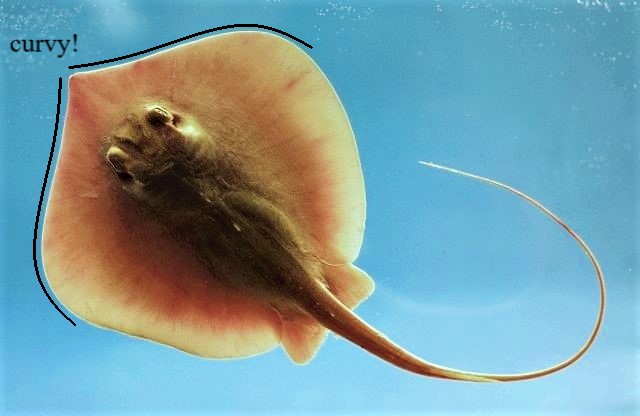 Atlantic Stingray
Atlantic Stingray
Bluntnose Stingray (NT) Southern Stingray (NT)
The three most common stingrays in the northern Gulf of Mexico are the Atlantic, the Bluntnose and the Southern. The Atlantic stingray, the most common of the three, has a “curvy” broadly rounded shape to its “wings”. The bluntnose stingray has more angluar shaped “wings” with a relatively straight margin. The Bluntnose may be confused with the Southern but the Southern has a row of thorns along the center of the disc (see above). Images, Public Domain: Atlantic and Southern stingrays, Brandi Noble, Pascagoula NMFS. Bluntnose stingray, NOAA/NEFSC.

Lesser Butterfly Ray (NT)
The butterfly ray is an unusual ray having no spine, a short tail and may be brown, grey, light green, or purple with light or dark spots or splotches. These small rays (25 inches maximum disc width) are completely harmless. Image by: Tomas Willems, CC BY-SA 3.0, https://commons.wikimedia.org/w/index.php?curid=24293440
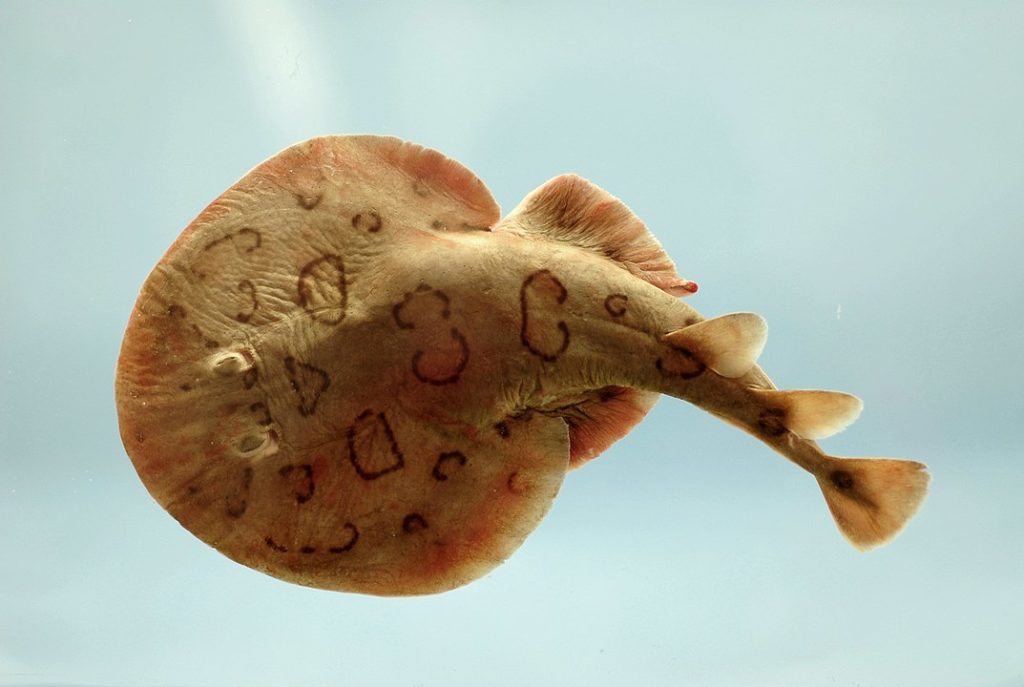
Lesser Electric Ray
This interesting ray if not at all uncommon in the northern Gulf of Mexico. It’s most memorable characteristic is its ability to generate a 14 to 37 volt electric shock which it uses to stun prey. It could be confused with the Torpedo Ray but the many irregular blotches, dark rings, ovals, and loops on its dorsal surface are unmistakable. Maximum size is about 18 inches. Image by Brandi Noble, Pascagoula NMFS, Public Domain.
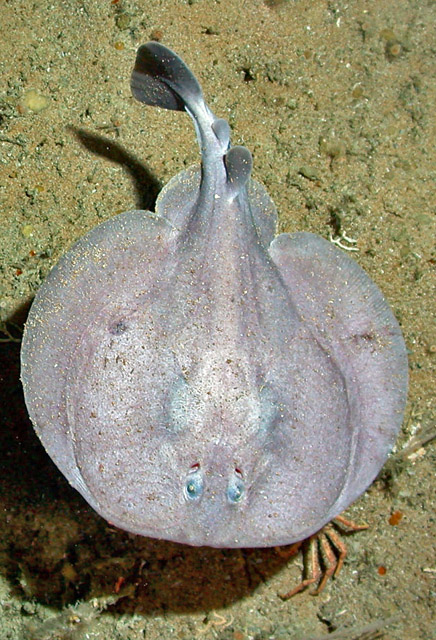
Atlantic Torpedo Ray
The Atlantic torpedo is not regularly observed in the northern Gulf of Mexico. It is dark brown, purplish brown or nearly black in color. The largest torpedos (6 feet!) produce a strong (220 volt) electric shock that could be dangerous, particularly to individuals with a pacemaker or heart condition. Not that the margin of the disc in front of the eyes is relatively straight while the lesser electric ray’s is curved (see above). Image Public Domain.
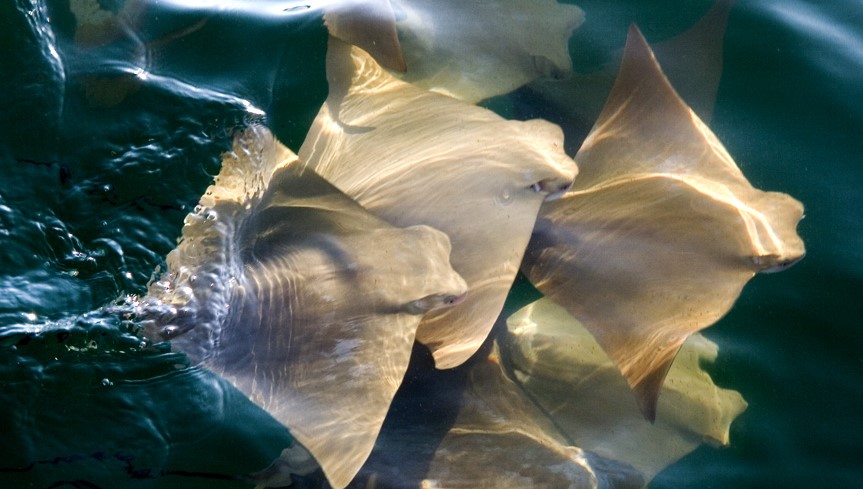
Cownose Ray
Massive schools of cownose rays can be observed in many place n the Gulf of Mexico. Deep groove around the front of the head and two lobes on the snout. The cownose is uniformly brown to olive brown on the upper surface. Maximum size is about 3 feet in width. Image Wikimedia Commons.
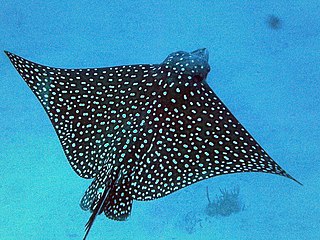
Spotted Eagle Ray (EN)
The Spotted Eagle Ray is not common in the northern Gulf of Mexico. It is distinctive with its elongate snout and the many white spots on a black, bluish, brown or olivaceous background. Maximum size is about 9 feet disc width. Photo credit, Dave Clausen, Wikimedia Commons.
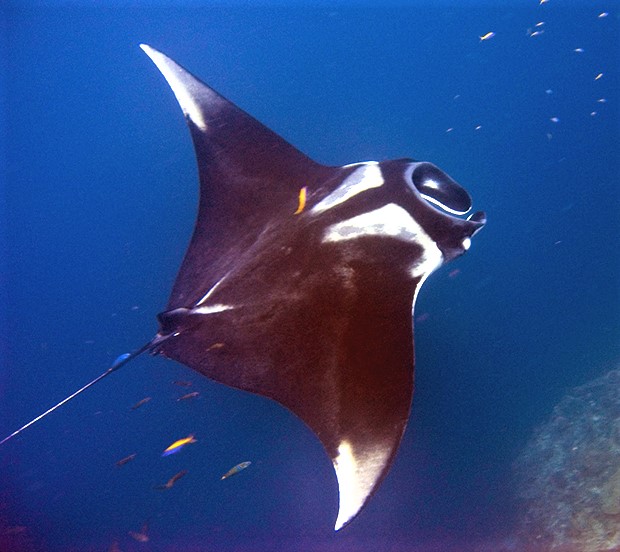
Giant Manta Ray (EN)
The Giant Manta Ray is the largest of all rays with maximum size reported to be 26 feet disc width. The Manta is blackish, reddish or brownish with occasional white patches and shoulders. The head is wide with two large “horns” extending forward. Image credit, John Hanson, Wikimedia Commons.
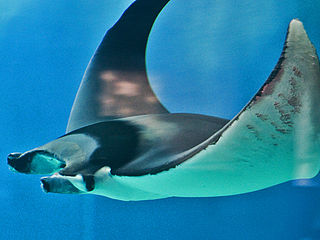
Devil Ray (EN)
The Devil Ray could be confused with the Giant Manta Ray. However, the Devil Ray has a narrower head and the color is very dark purple to black above and lacks the white coloration that is present in the Manta Ray. It is considerably smaller than the Manta with maximum size being only about 4 feet. Image credit, Patrik Neckman, WIkimedia Commons.
Yellow Stingray
It would be unusual to observe the Yellow Stingray in the northern Gulf of Mexico since they are very uncommon there. They are, however, more abundant in the southern Gulf and Caribbean. No other ray in our area looks like the Yellow Stingray. The spine of this ray is very toxic and, although not life-threatening, is exquisitely painful.
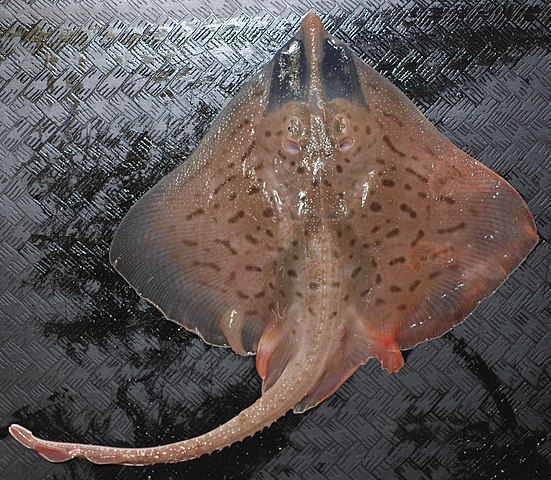
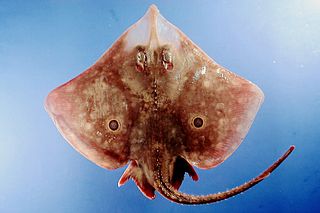 Clearnose Skate Roundel Skate
Clearnose Skate Roundel Skate
The Clearnose Skate is the most common skate in northern Gulf of Mexico shallow waters. The Roundel Skate is less common. The two ocellated (eye-like) spots on the dorsal surface of the Roundel make them easily distinguishable. The skates do not have a stinging spine like the stingrays and these fishes are harmless. Maximum size is about 3 feet for the Clearnose and 2 for the Roundel.
5. Sawfishes

Largetooth Sawfish (CR) and Smalltooth Sawfish (CR)
There are only two species of sawfishes in our area, the Largetooth and Smalltooth Sawfishes. These fishes are critically endangered and if you capture one it is very important to get a photo of the “saw” of the fish such that the number of teeth on one side of the saw can be counted AND to return the fish to the water as quickly as possible. The Largetooth Sawfish has 16 to 22 teeth along one side of the “saw” and the Smalltooth has 23 to 34 teeth (see below)
